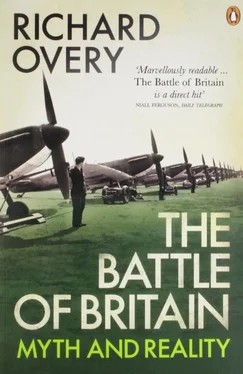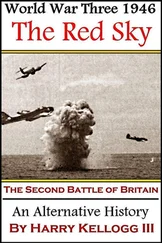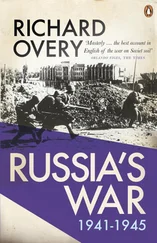…the point to remember is that the losses sustained by the enemy were so great that heavy day attacks by bombers were brought to a standstill and that the Command did, in fact, win a notable victory; since, if the attacks had not been brought to a standstill, the invasion would have been facilitated and the war might well have been lost. 14
It is this achievement that came to be described as the Battle of Britain.
Victory in this narrow but important sense has been explained in many ways. German airmen were at a disadvantage attacking over enemy territory with very limited fighter range. Fighter Command was able to draw on the resources of the other nine-tenths of the British Isles outside the range of the Me 109. Even if the forward airfields had been lost permanently, British fighter forces could still have been deployed from bases further inland, though they might then have taken a lower toll of the enemy bomber force. The German fighter force became tied to the bomber stream as the battle drew on, limiting its radius of action and manoeuvrability without affording the bombers real security from attack on the way out or the way back. All the time Fighter Command was improving the means to identify and engage the enemy through radar and signals intelligence.
In a great many respects, however, the two forces were remarkably matched. Both commanded a small group of committed, highly trained and courageous pilots; both forces responded with considerable tactical ingenuity to sudden changes of direction in the course of the battle; both exploited fighter aircraft at the cutting edge of aviation technology; both forces fought the battle with operational commanders of real distinction – Dowding and Park, Kesselring and Sperrle. There were periods in the battle that favoured the German side, others in which Fighter Command began to exact a higher toll. Every small technical or tactical drawback suffered by one force can be matched by problems experienced by the other.
The contest was not, of course, a draw. German air fleets did not gain air supremacy over southern Britain, for all their skill and technical competence. Two factors gave the edge to the RAF: the balance of forces between the two sides, and the role of intelligence. For the whole of the battle period, the British aircraft industry outproduced the German by a considerable margin. This allowed a continuous flow of replacements to compensate for the higher loss rates sustained by Fighter Command. The Command grew steadily stronger between June and October. On 19 June there were 548 operationally ready fighters (with 200 more ready for the following day); on 31 October there were 729 ready to fly, 370 in store at a day’s notice, and a further 110 at four days’. 15German levels of production and serviceability were too low to establish an effective numerical superiority. German fighters flew in large groups with the bombers, which gave an impression of overwhelming numbers, while Fighter Command aircraft were divided between Groups, not all of which were in the front line. But Dowding’s system of rotation ensured that most squadrons saw service in southern England, and that each German attack was met in sufficient force to exact casualties.
The balance of pilots was also more favourable than the legend of the ‘few’ suggests. German single-engined fighter pilots available for the battle remained below the British figure throughout the three months of combat. The impact of regular fighting under difficult conditions eroded combat numbers. At the beginning of September only 74 per cent of German fighter pilots were operationally ready, and that month pilot losses reached almost one-quarter of the force, 23.1 per cent. 16Moreover, and importantly, German pilots and aircrew were lost to the battle if they were shot down and captured on British soil. Between 1 July and 31 October, 967 prisoners were taken and 638 bodies definitely identified. The ΡOWs were found to be experienced pilots. Only two had been trained since the war began. The oldest was fifty-one years old, a veteran of the First World War; the oddest was the 47-year-old Oberleutnant Haffl von Wedel, a Berlin history professor recruited to write the air force official history, who was permitted to fly in combat to give his scholarship a practical foundation. He was shot down on his twenty-fourth mission. 17The pre-war origin of the pilot population suggests that the German Air Force suffered the loss during the battle of a high proportion of its cadre force. Nor was there to be any heroic break-out from POW camps; three-quarters of those captured were shipped overseas to Canada. 18
The true balance of forces was never properly understood on either side. The result was a mutual misperception that played a critical part in the conduct of the battle. Throughout the summer, indeed ever since the outbreak of war, German Air Intelligence, run by Colonel Josef ‘Beppo’ Schmidt, had greatly underestimated the size of the RAF and the scale of British aircraft production. Across the Channel the Air Intelligence division of the Air Ministry consistently over estimated the size of the German air enemy and the productive capacity of the German aviation industry. As the battle was fought, both sides exaggerated the losses inflicted on the other by an equally wide margin. However, the intelligence picture formed before the battle encouraged the German Air Force to believe that such losses pushed Fighter Command to the very edge of defeat, while the exaggerated picture of German air strength persuaded the RAF that the threat it faced was larger and more dangerous than was actually the case.
German misperception encouraged first complacency, then strategic misjudgement. The shift of targets from air bases to industry and communications was taken because it was assumed that Fighter Command was virtually eliminated. On 16 September, the day after the mauling inflicted on the daylight bomber raids against London, Goering announced that Fighter Command had just 177 operational aircraft left. German Air Intelligence estimated that there were only 300 British fighters left altogether, including reserves, and a monthly output of 250. On 19 September Fighter Command had an actual operational strength of 656; there were 202 aircraft in immediate reserve, 226 in preparation; output of fighters between 7 September and 5 October was 428. 19The discrepancy was critical. German airmen were ordered to fight in September as if Fighter Command had been all but eliminated; the reality was a level of attrition so high that the German Air Force could not sustain it for more than a few weeks. The casualties of this paradox were German aircrew who fought a battle that bore little relation to the one their commanders told them to expect.
Fighter Command, on the other hand, could not afford to be complacent. The high losses inflicted on the German Air Force reduced the threat, but as long as it was assumed that the enemy was much stronger there could be no question of relaxing any particle of effort. In the western intelligence community there existed a profound misapprehension of the scale and character of the German air fleets, even though by August details were being supplied regularly from ‘Ultra’ decrypts of German Air Force Enigma traffic. For a long time it was assumed that each German squadron was stronger than it actually was because the balance between reserves and operational aircraft had not been properly understood. American air intelligence officers calculated German aircraft output at around 26,000 in 1940, rising to 42,000 in 1941, with at least 31,000 pilots trained between July 1939 and December 1940 to fly them; German first-line combat strength was estimated at 11,000, with 100 per cent reserves. British estimates were more modest than this: Air Intelligence suggested output of 24,400 aircraft in 1940, and a front-line strength of 5,800 in August. The true figures were far below these estimates. Aircraft output was in fact only 10,247 in 1940 and 12,401 in 1941; German Air Force first-line strength in September 1940 was 3,051 aircraft of all types, of which 2,054 (68 per cent) were serviceable. Of this figure approximately 80 per cent was used for the assault on Britain. 20Some intelligence estimates were better than others (the Ministry of Economic Warfare was spot on with an estimate of 3,000 front-line strength, but was disregarded by the airmen). Not until the spring of 1941 did estimates begin to approach reality. The British fought the air battle as if it were a last-ditch struggle against an overwhelming enemy; the German side fought against a force persistently misrepresented as technically and tactically inept, short of aircraft, pilots and bases. This psychological contrast put the German Air Force at a perpetual disadvantage.
Читать дальше












